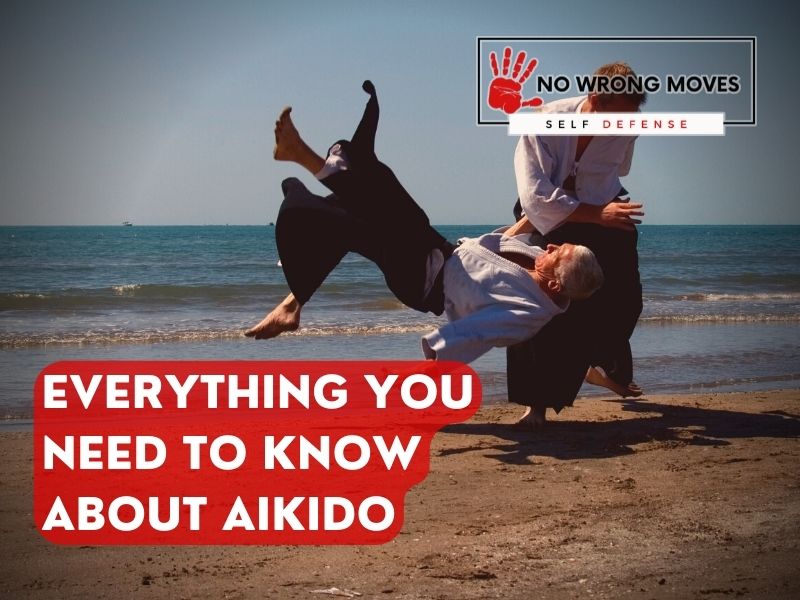
- What is This Martial Art? Everything You Need To Know About Aikido
- Where Does Aikido Come From? What’s The Story?
- Benefits of Aikido
- How to get started in Aikido
- What To Expect In Your First Aikido Class
- Different Aikido Ranks And Levels
- The Importance of A Good Aikido Instructor
- Aikido Movies And Figures
- The Wrap-Up
So you want to know more about Aikido? Eager to learn about it before you actually hop into it? Trust me, you've made the right call. There are lots of things this wonderful martial art can offer you, and you'd be wise to try and pick these benefits up for yourself.
Or maybe not! Maybe you just have a passing interest in the martial art. Maybe you're just curious to figure out more about it. If you are, then that's cool too! And I'd be glad to help you out here.
In this post, I'll tell you everything you need to know about Aikido, focusing on the following;
- What Aikido is;
- Where Aikido comes from;
- The benefits of Aikido ;
- How to get started in this martial art;
- What to expect for your first Aikido class;
- Aikido's different ranks and levels;
- The importance of a good Aikido instructor;
- Using Aikido for self-defense.
And by the end of all this, you'll have everything you need to sate your Aikido curiosity. Let's get straight into it!
What is This Martial Art? Everything You Need To Know About Aikido

Aikido, the art of peace. Founded over fifty years ago by Master Munehide Uyeshiba who still practiced the discipline beyond the age of due to his love for this style.
It's a style that has been passed down through generations, teaching its practitioners to defend themselves while causing the least harm possible to their attacker.
The main elements of Aikido involve redirecting the energy and force of an attacker, using their own momentum against them while simultaneously controlling and neutralizing the situation. This is achieved through various throws, joint locks, and pins.
Mastering Aikido requires discipline, focus, and a strong connection to the principles of peace and harmony. It is not just an effective form of self defense, but also a way to cultivate inner peace and balance.
As Master Uyeshiba's philosophy states, the essence of Aikido is to harmonize with nature's laws, to seek unity with the universe, and to cultivate a spirit of love.
Practicing Aikido allows us not only to protect ourselves physically, but also mentally and spiritually. It is a path towards self-improvement and enlightenment. That is the true power of Aikido.
Where Does Aikido Come From? What’s The Story?

The history of Aikido is reflective of the country in which it was born. Japan has seen many changes throughout its history, with power changing hands frequently.
This constant flux led to the development of a complete fighting system for the Samurai, who were always prepared for battle.
The Tokugawa Family brought stability to Japan in the 17th century, and Aikido naturally evolved from Aiki-Jutsu during this time. The techniques developed during real combat were preserved and enhanced, and are still practiced today.
Aikido focuses on redirecting energy and avoiding strikes, and can be applied effectively in multiple scenarios. Through training and practice, the practitioner is able to react instinctively and efficiently to any attack.
Aikido's founder, Morihei Ueshiba, dedicated his life to perfecting the art. He eventually achieved enlightenment and believed that true Aikido is love and protection for all beings.
The philosophy of Aikido stresses harmony and peace, rather than aggression or domination over others.
Aikido continues to grow in popularity worldwide, with practitioners valuing its focus on self-improvement and peaceful resolution of conflict.
Its techniques can be adapted for use in everyday situations, making it a practical and valuable skill for anyone to learn.
Benefits of Aikido

Aikido offers an excellent opportunity to attain and maintain physical fitness. The practice incorporates a range of movements that engage various muscle groups, resulting in improved overall fitness levels.
On top of that, it's a highly effective way to learn self-defense techniques that can be useful even in intense real-life situations.
One of the significant benefits of Aikido is the impact it has on flexibility. The movements involved in Aikido require extensive stretching, resulting in increased range of motion and flexibility.
This increased flexibility also helps to prevent injuries and soreness during and after training sessions.
Another advantage of Aikido is that it enhances balance. Practicing Aikido requires constant shifts in weight and footwork, improving balance and stability. Better balance can help to prevent falls and injuries, making it an essential aspect of physical fitness.
Moreover, Aikido promotes better breathing and circulation by teaching practitioners to breathe deeply and focus on their breath during movements. This mindfulness practice helps to reduce stress levels, lower blood pressure, and improve overall health.
Lastly, practicing Aikido is an excellent way to improve coordination. The movements in Aikido require precision and accuracy, leading to better coordination skills. Improved coordination can help in everyday life, including better hand-eye coordination and motor skills.
How to get started in Aikido
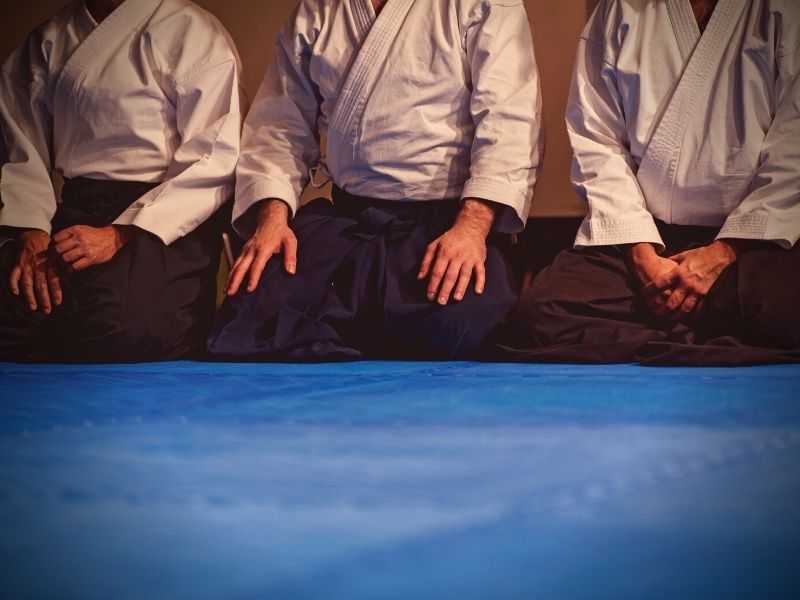
Starting your journey in Aikido can be both exciting and overwhelming. However, with the right mindset and approach, you can make the most out of your training experience.
To begin, it's essential to research various Aikido schools and find one that resonates with your personal goals and beliefs.
Once you've identified a potential school, attend a trial class to get a feel for the atmosphere and instructors. This will give you an opportunity to gauge if the school is a good fit for you.
Next, focus on learning the basic techniques, principles, and forms of Aikido under the guidance of a qualified instructor. You'll absolutely need consistent practice in order to develop your technique and understanding of Aikido's many principles.
In addition to regular practice, challenging yourself through attending workshops and seminars, sparring with other practitioners, and seeking new opportunities for growth within the Aikido community will accelerate your progress.
Watching and studying Aikido masters, both online and in competitions, can also be a great source of inspiration and new insight into the art.
Remember to approach your practice with humility and an openness to learning. That's a big part of what makes Aikido... well, Aikido, after all--a journey of continuous improvement and self-discovery.
What To Expect In Your First Aikido Class
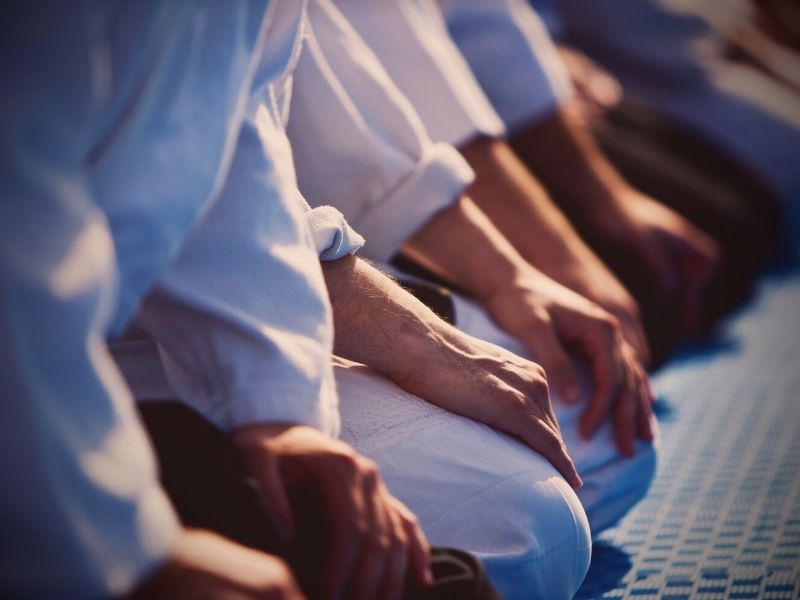
In your first Aikido class, you can expect to be welcomed into a supportive and encouraging environment.
Aikido is an exciting and dynamic martial art that will seriously challenge you physically and mentally, but it will also reward you for every ounce of effort you put into it.
Your first class will almost certainly start with a warm-up, done to get your body ready for the exercises and techniques that you'll be learning for the day. That'll include stretching, cardio, and strength training exercises.
You shouldn't underestimate these, trust me. You should expect to sweat loads and to feel pretty intense burning sensations in your muscles, as a result of heavy lactic acid build-up in your body. But don't worry, that's all part of the process!
After the warm-up, your instructor will introduce you to the basic techniques and movements of Aikido. Eventually, your training will actively involve practicing with a partner.
If this sounds intimidating to you, then don't worry too much! Your instructor will guide you through each step and provide feedback to help you improve.
Finally, your first class will end with a cool-down and stretching session, done both to help prevent injuries and aid you in your recovery. Your instructor may even take some time to answer any questions you have about Aikido, as well as what you should expect in future classes.
So in your first Aikido class, you should expect to be challenged, learn new skills, and be surrounded by supportive and like-minded individuals. Things'll be tough, absolutely, but it'll be a deeply enjoyable experience too--of that, I can almost guarantee you.
Different Aikido Ranks And Levels
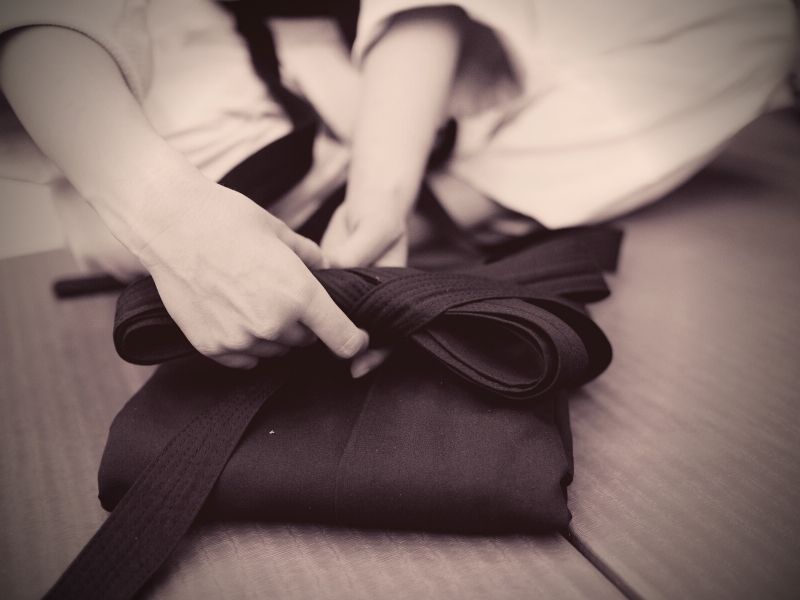
There are different levels in Aikido, and these belts correspond to those levels.
Aikido Belt Ranks
The first level is the white belt, which is the beginner's level. Once you have mastered the basics of Aikido, you can move on to the blue belt, which is the intermediate level.
And finally, once you have mastered the art of Aikido, you can become a black belt, which is the highest level.
There are three degrees as a black belt holder: 1st dan, 2nd dan, and 3rd dan black belt. In order to achieve each of these degrees, you must pass a test that proves your mastery of Aikido.
Aikido Ranks, Belts, And Colors Outside Of The Traditional Ranking System
In some Western Aikido schools, there are more ranks added in between 1st dan and 2nd dan. These ranks can be any combination of colors but typically follow this sequence: black, white, brown, blue.
This allows for students to be promoted at a more gradual pace and helps to distinguish between students of different ranks.
The Importance of A Good Aikido Instructor

As with any martial art, it's crucial for you to choose the right Aikido teacher when you first start learning. A good teacher will have a deep understanding of the techniques and principles of Aikido and be able to communicate this knowledge to their students effectively.
They will also be able to adapt their teaching style to suit the individual needs of each student. In addition, a good teacher will be patient and supportive, and they will create a positive and encouraging learning environment.
We really can't overstate this. Choosing the right teacher is just that important for getting the most out of your Aikido training, so take your time and do your research before making a decision.
Aikido Movies And Figures
These are some of the top movies and shows with Aikido in them:
- The Blind Swordsman: Zatoichi (2003)
- The Last Samurai (2003)
- Kill Bill: Vol. 1 (2003) and Kill Bill: Vol. 2 (2004)
- Street Fighter (1994)
- Ong-Bak: The Thai Warrior (2003)
- The Challenge (1982) TV series
Aikido can also be seen in popular shows such as:
- Daredevil (2015) TV series
- Arrow (2012) TV series
- Alias (2001-2006) TV series
- Chuck (2007-2012) TV series
- Xena: Warrior Princess (1995-2001) TV series
And just in case you wanted to do some more research, here are some notable figures who practice or have practiced Aikido.
- Actor Steven Seagal
- Musician and filmmaker Jean-Luc Ponty
- Actor Peter Brosnan
- Author and speaker Deepak Chopra
- Actress Cynthia Rothrock
The Wrap-Up
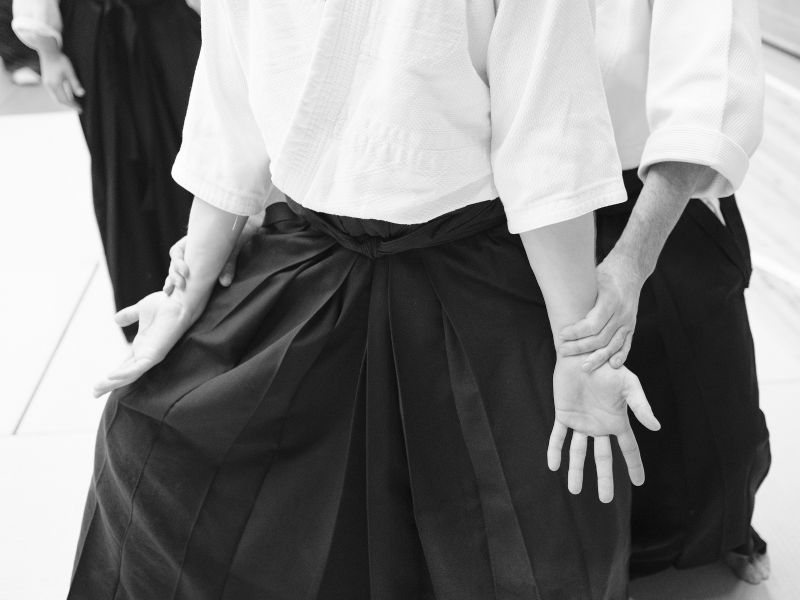
So! That's about all we've got for Aikido. As you've just read, this incredible martial art has tons to offer you.
It's got a rich history waiting for you to discover it and diverse techniques waiting for you to learn them. That's all on top of its excellent psychological benefits, excellent sense of community, opportunity to acquire self-defense skills, and offer for overall improved physical fitness.
So if you're interested in exploring this ancient martial art, I'd highly encourage you to take the first step today. Start your journey towards becoming an Aikido practitioner!
You'll need tons of dedication and practice, definitely, but you might find that this amazing martial art can help you achieve more than you ever thought possible.
[author-box-jpx-fitness]
